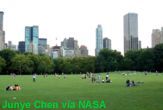Urban Heat Makes Cities … Greener?

Who would have thought plants might prefer the city life.
Satellite images show that the higher temperatures in urban environments extend the growing season by two weeks, according to new research.
The term "urban heat islands" has for decades been used to describe the fact that roads and concrete buildings retain heat better than rural terrains.
Using NASA's Moderate Resolution Imaging Spectroradiometer on the Terra satellite, researchers measured the surface temperature in and around 70 cities in eastern North America. They found that these concrete jungles were hotter than the surrounding countryside by an average 2.3 degrees Celsius during the spring of 2001.
By also measuring the amount of green light coming from the observed regions, the scientists were able to estimate the growing season duration.
"The baseline greenness in each area will be different," said Xiaoyang Zhang from Boston University, but he and his collaborators attributed any sharp increase in greenness to the first bloom of spring at that location.
A corresponding decrease was taken to be the beginning of fall. The analysis accounted for changes in sunlight, cloud cover and snowfall (but apparently it did not adjust for spikes due to St. Patrick's Day).
Get the world’s most fascinating discoveries delivered straight to your inbox.
Zhang and his colleagues found that vegetation "greenup" in cities started seven days earlier, and lasted eight days longer, than it did in adjacent rural sites. They were slightly surprised by how much the growing season increased.
"Fifteen days seems a lot," Zhang said.
The research team also measured how far spatially the urban heat island effect extends. The results, published in the journal Geophysical Research Letters, showed that growing cycles were significantly affected six miles outside of city boundaries. This implied that the ecological "footprint" of urban climates is 2.4 times larger than the area subsumed by eastern North American cities.
The impact may be different in other parts of the world. Zhang explained that, "In the western half of North America, because it is drier, vegetation growth is mainly controlled by rainfall."
But in the generally more humid east, temperature is a more important determinant of growing seasons, and therefore, the cities in this study are thought to reflect the effect of global warming on plant life.
Zhang and his colleagues will continue monitoring the growing cycles around urban areas, and they plan to make publicly available the latest data every three months.
"We have not analyzed [urban growing seasons] for a long enough period, but I think theoretically that they have been increasing because there is more development now," Zhang said.



